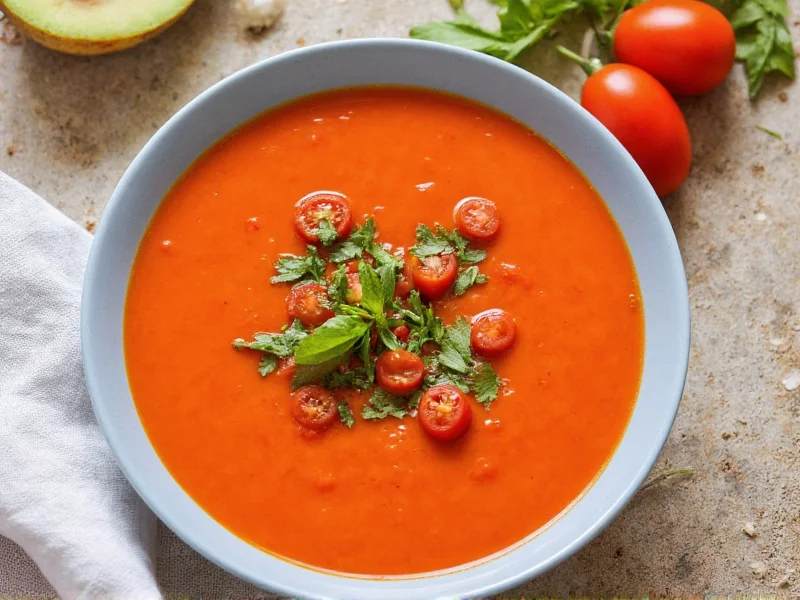Gazpacho represents one of Spain's most iconic culinary contributions, embodying the essence of Mediterranean cuisine with its simple yet sophisticated approach to fresh ingredients. This chilled soup has sustained its popularity for centuries not just because of its refreshing qualities, but because it perfectly utilizes seasonal produce at its peak freshness. Unlike cooked soups, gazpacho preserves the natural enzymes and nutrients of raw vegetables, making it both a culinary delight and nutritional powerhouse.
Historical Origins of Traditional Gazpacho
The history of gazpacho soup traces back to pre-Roman times when Iberian peasants combined stale bread, olive oil, vinegar, and garlic—a combination known as ajoblanco. The tomato-based version we recognize today emerged after tomatoes arrived from the Americas in the 16th century. Originally a humble field worker's meal, gazpacho gained sophistication as Spanish cuisine evolved. Andalusian farmers created this no-cook soup to stay hydrated during scorching summer harvests, blending available vegetables with bread to create a complete, portable meal.
Essential Ingredients for Authentic Gazpacho
Creating genuine Spanish gazpacho requires specific ingredients that work in harmony. While regional variations exist, the Andalusian standard maintains particular ratios and components that distinguish it from imitations. The quality of each ingredient directly impacts the final flavor profile, making selection critical for an exceptional result.
| Core Ingredient | Required Quantity | Quality Considerations |
|---|---|---|
| Ripe tomatoes | 2 lbs (900g) | Varieties like Raf or beefsteak preferred; must be fully ripe |
| Cucumber | 1 medium | Peeled and seeded for smoothest texture |
| Green bell pepper | 1/2 | Must be fresh with no bitterness |
| Stale bread | 2 oz (60g) | Traditional rustic bread, not sweetened |
| Extra virgin olive oil | 1/4 cup (60ml) | High quality Spanish variety essential |
| Sherry vinegar | 2 tbsp | Authentic aged sherry vinegar preferred |
Step-by-Step Preparation Method
Authentic gazpacho preparation follows specific techniques that maximize flavor extraction while maintaining the soup's characteristic texture. Unlike improvised versions, traditional preparation requires patience and attention to detail:
- Prepare vegetables: Peel tomatoes after briefly blanching, remove cucumber seeds, and eliminate white membranes from bell peppers
- Soak bread: Submerge stale bread in water or vinegar mixture until fully saturated but not disintegrated
- Initial blending: Process vegetables separately from bread and liquids for optimal texture
- Emulsification: Slowly incorporate olive oil while blending to create stable emulsion
- Straining: Pass through fine mesh sieve for silky texture (optional but traditional)
- Resting: Refrigerate minimum 4 hours, preferably overnight for flavor development
Regional Variations Across Spain
While Andalusian tomato gazpacho dominates international perception, Spain features numerous regional variations that showcase local ingredients and traditions. Understanding these differences provides insight into Spain's culinary diversity:
- Ajoblanco: White gazpacho from Malaga and Granada made with almonds, garlic, and bread—no tomatoes
- Salmorejo: Thick Cordoban version with higher bread ratio and garnished with serrano ham
- Porra antequerana: From Antequera, featuring cooked rather than raw tomatoes
- Gaspatxos: Catalan variation often includes roasted peppers and less bread
Nutritional Profile and Health Benefits
Gazpacho soup delivers exceptional nutritional value through its raw vegetable composition. Research published in the Nutrition Reviews journal indicates that regular gazpacho consumption correlates with reduced inflammation markers. The soup's lycopene content increases when tomatoes are blended raw, providing up to 50% more bioavailable lycopene than cooked tomato products. Each serving typically contains:
- Approximately 120 calories per 1.5 cup serving
- 3 grams of dietary fiber supporting digestive health
- High concentrations of vitamins A, C, and E
- Significant potassium and magnesium content
- Natural electrolytes for hydration maintenance
Serving Traditions and Pairing Suggestions
In Spain, gazpacho follows specific serving customs that enhance the dining experience. Traditionally served in wide, shallow bowls rather than deep soup plates, the presentation allows aromas to disperse properly. Temperature matters significantly—gazpacho should be served between 42-46°F (6-8°C), colder than typical refrigerator temperature. Common traditional accompaniments include:
- Chopped hard-boiled eggs sprinkled on top
- Diced serrano ham for protein enhancement
- Finely minced spring onions as garnish
- Croutons made from the same bread used in preparation
- Drizzle of premium olive oil just before serving
Storage and Preparation Timing Tips
While gazpacho tastes best when prepared 12-24 hours in advance, proper storage techniques affect both flavor development and food safety. The acidic nature from tomatoes and vinegar creates a relatively stable environment, but certain precautions remain essential:
- Store in airtight container for up to 3 days
- Keep separate from strong-smelling foods in refrigerator
- Stir thoroughly before serving as ingredients may separate
- Avoid freezing as it destroys the delicate texture
- Prepare vegetables separately if making more than 24 hours ahead
Common Preparation Mistakes to Avoid
Many home cooks encounter issues with their gazpacho due to preventable errors. Understanding these pitfalls ensures restaurant-quality results every time:
- Using unripe tomatoes: Creates sour, underdeveloped flavor profile
- Skipping the resting period: Flavors don't properly meld without chilling time
- Incorrect oil incorporation: Adding oil too quickly breaks emulsion
- Over-blending: Incorporates too much air, causing oxidation and color change
- Using sweetened bread: Alters authentic savory profile
Modern Interpretations and Creative Variations
Contemporary chefs have expanded gazpacho possibilities while respecting traditional foundations. Innovative variations maintain the core preparation method while introducing complementary ingredients:
- Fruit gazpachos: Watermelon or strawberry versions for summer
- Avocado gazpacho: Adds creaminess without dairy
- Smoked paprika enhancement: For deeper flavor dimension
- Herb-infused variations: Basil or cilantro for different flavor profiles
- Seafood gazpacho: Served with shrimp or crab for meal transformation











 浙公网安备
33010002000092号
浙公网安备
33010002000092号 浙B2-20120091-4
浙B2-20120091-4